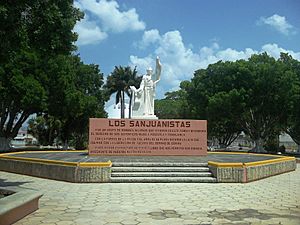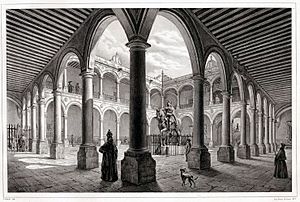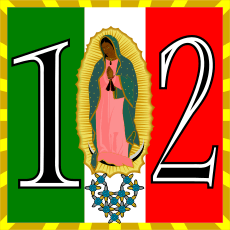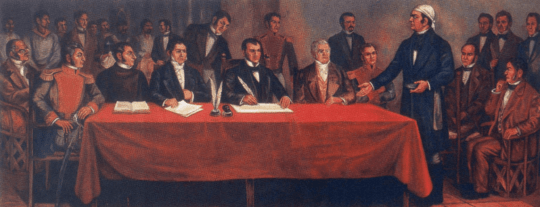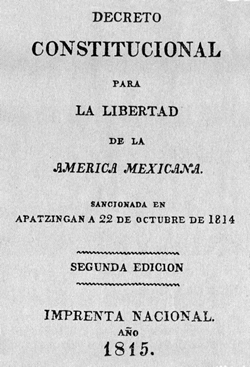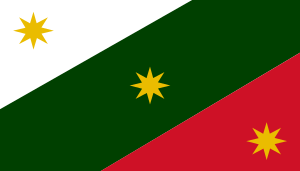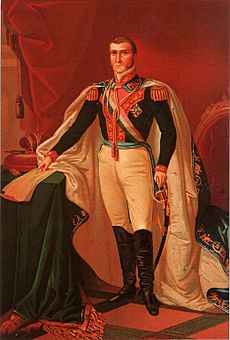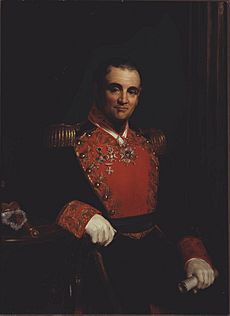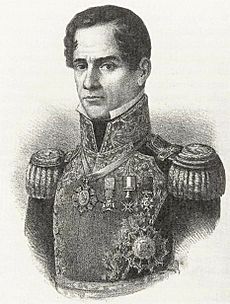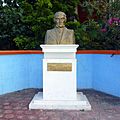Andrés Quintana Roo facts for kids
Quick facts for kids
Andrés Quintana Roo
|
|
|---|---|
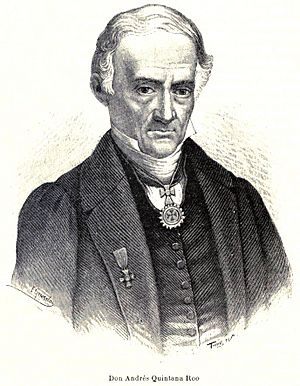 |
|
| Minister of Foreign and Domestic Relations | |
| In office August 11, 1822 – February 22, 1823 |
|
| Preceded by | José Manuel de Herrera |
| Succeeded by | José Cecilio del Valle |
| Congressional Deputy | |
| In office January 1, 1827 – December 30, 1830 |
|
| President of the Chamber of Deputies | |
| In office 1830–1830 |
|
| Preceded by | Miguel Domínguez |
| Succeeded by | Miguel Valentín y Tamayo |
| Congressional Deputy | |
| In office March 29, 1833 – May 15, 1834 |
|
| President of the Chamber of Deputies | |
| In office 1833–1833 |
|
| Preceded by | Juan Rodrígues Puebla |
| Succeeded by | José de Jesús Huerta |
| Minister of Justice | |
| In office September 14, 1833 – July 1, 1834 |
|
| Preceded by | Joaquín de Iturbide |
| Succeeded by | Juan Cayetano Gómez de Portugal y Solís |
| Minister of the Supreme Court of Justice of the Nation | |
| In office 1834–1851 |
|
| Personal details | |
| Born | November 30, 1787 Mérida, Yucatán, Viceroyalty of New Spain |
| Died | April 15, 1851 (aged 63) Mexico City, Mexico |
| Resting place | Ángel de la Independencia, Mexico City |
| Spouse | Leona Vicario |
| Children |
|
| Parents |
|
| Signature |  |
Andrés Eligio Quintana Roo (born November 30, 1787 – died April 15, 1851) was an important Mexican leader. He was a lawyer, writer, and politician who fought for Mexico's independence. His wife, Leona Vicario, was also a key figure in the independence movement.
Quintana Roo played a big role in the Mexican War of Independence. He was part of the Congress of Chilpancingo. This group wrote Mexico's first Declaration of Independence in 1813. He served many times in the Chamber of Deputies, even as its president twice. He also worked as a judge in Mexico's Supreme Court. Quintana Roo started and edited several newspapers, like El Ilustrador Americano and El Federalista Mexicano. The Mexican state of Quintana Roo is named after him.
Contents
Early Life and Education
Andrés Quintana Roo was born in Mérida, Yucatán. His parents were José Matías Quintana and María Ana Roo de Quintana. His family had roots from the Canary Islands. They had lived in the Yucatán Peninsula for a long time.
Becoming a Sanjuanista
In 1805, Andrés's father joined a group called the Sanjuanistas. This group met to talk about important social and political issues. They were especially concerned about the slavery of the native people. The group met at the Ermita de San Juan Bautista, which is how they got their name. Their leader was a priest named José María Velázquez.
In 1808, the French army invaded Spain. This caused a big political crisis. In 1810, a special meeting called the Cortes of Cádiz took place in Spain. This meeting discussed the future of the Spanish Empire. The Sanjuanistas were very interested in these changes.
In 1812, the Cortes of Cádiz created a new Spanish constitution. The Sanjuanistas quickly supported this new constitution. They pushed the governor of Yucatán to follow it. However, many people opposed these changes. They were called the Rutineros. The Sanjuanistas wanted social change and freedom from Spain. The Rutineros wanted to keep things as they were. When the first printing press came to Yucatán in 1813, both groups used newspapers to share their ideas.
In 1814, King Fernando VII returned to power in Spain. He got rid of the new constitution. He ruled as an absolute king. This made things hard for the Sanjuanistas. Andrés's father was arrested and jailed.
Andrés's Education Journey
Andrés Quintana Roo studied at the Seminario de San Ildefonso de Mérida. He was a very talented writer. By age 15, in 1802, he had finished his Latin studies. He continued to study Arts, Theology, and Doctrine. His teachers said he was very smart for his age.
In 1808, he moved to Mexico City to study at the Real y Pontificia Universidad de Nueva España. He had a strong recommendation letter from his bishop. It said he was very dedicated and talented. In early 1809, he earned his Bachelor of Arts and then his Bachelor of Doctrine. After graduating, he worked for two years at a law firm.
Meeting Leona Vicario
While working at the law firm, Quintana Roo met Leona Vicario. She was the niece of his boss. Leona's parents had passed away, and her uncle was her guardian.
Andrés and Leona shared many interests. They both loved writing, art, politics, and freedom. They fell in love. Around 1811, Quintana Roo asked Leona's uncle for permission to marry her. Her uncle refused. After this, Quintana Roo left his law job.
Fighting for Independence
In 1812, Andrés Quintana Roo decided to fully support the independence movement. He traveled to Tlalpujahua to join the army of Ignacio López Rayón. López Rayón had been a close helper to Miguel Hidalgo y Costilla. Hidalgo was the priest who started the fight for independence in 1810.
Quintana Roo used his writing skills to help the cause. He wrote for the rebel newspaper El Ilustrador Americano. In July 1812, he started his own newspaper, El Semanario Patriótico Americano. He also wrote a famous patriotic poem called "Dieciséis de septiembre" (Sixteenth of September).
The Secret Group: Los Guadalupes
Ignacio López Rayón was very good at organizing. He created a group of spies and people who spread information. This group was called Los Guadalupes. They chose this name to show their support for the Virgin of Guadalupe. This was different from the Spanish who honored another virgin. To stay safe, Los Guadalupes used secret names.
Not many people were known to be part of this group. Most of them were lawyers in Mexico City. But the group also included women, priests, and nobles. They sent news, money, and weapons to López Rayón. Most importantly, they helped López Rayón communicate with another important leader, José María Morelos y Pavón.
Leona Vicario was very involved with Los Guadalupes. In February 1813, one of her letters was caught. She was warned that she might be arrested, so she fled Mexico City. Her uncle convinced her to return, and she was held as a prisoner.
When Quintana Roo heard about Leona's imprisonment, he sent friends to rescue her. They dressed up as royal officers and sneaked her out. They helped her escape Mexico City disguised as mule drivers. Soon after, Andrés Quintana Roo and Leona Vicario were married in Tlalpujahua.
The Congress of Chilpancingo
After some military losses, José María Morelos decided to unite the rebel groups. He called for a congress to meet in September 1813 in Chilpancingo. Quintana Roo was first elected as vice president. Then he became president of the congress.
The main goal of this congress was to write a constitution. On the first day, Morelos shared his ideas for an independent Mexico in a document called Sentimientos de la Nación. Then, on November 6, the congress signed the Acta Solemne de la Declaración de la Independencia de la América Septentrional. Quintana Roo helped write this important document.
After the Declaration, Morelos tried to capture the city of Valladolid. But his army was defeated by Agustín de Iturbide. Morelos's general, Mariano Matamoros, was captured and executed. Morelos was later removed from his command.
Because of these defeats, Quintana Roo and the Congress had to move often. On October 22, 1814, in Apatzingán, they created the Decreto Constitucional para la Libertad de la America Mexicana. This is better known as the Constitution of Apatzingán. Quintana Roo helped write this constitution.
In 1814, King Fernando VII returned to power in Spain. He sent more soldiers to Mexico. Iturbide increased his efforts against Morelos and the Congress. Many areas won by Morelos were lost. The Congress was always on the move. In November 1815, Morelos was captured while protecting the Congress's retreat. He was executed in December. After this, the Congress was dissolved.
A Time of Amnesty
While other leaders fled, Andrés Quintana Roo and Leona Vicario stayed in Michoacán. They had been offered pardons, but they refused. They spent most of 1816 hiding. A new, more forgiving viceroy, Juan Ruiz de Apodaca, took over. He offered leniency to rebel leaders who surrendered. Still, Quintana Roo would not accept a pardon.
On January 3, 1817, their first child, Genoveva, was born in a cave. With a baby, it became much harder to hide. In March 1818, they were found. Leona agreed to be taken, and Quintana Roo surrendered soon after. He was worried about his wife's safety.
Both Quintana Roo and Vicario accepted pardons. They settled in Toluca. Quintana Roo then worked to become a lawyer again. In August 1820, he was accepted into the Royal Bar Association. The family then moved to Mexico City.
The Plan of Iguala
In April 1820, news reached Mexico that Spain had a new revolution. King Fernando VII was forced to accept the liberal Constitution of Cádiz again. This meant more freedom, including freedom of the press. Quintana Roo published an article celebrating this change in Mexico.
However, the conservative leaders in Mexico saw these changes as a threat. They met secretly to stop the news from spreading. Their plan was to declare Mexico independent and create an absolute monarchy. They wanted to prevent a parliament that would limit their power. They convinced Viceroy Apodaca to put Agustín de Iturbide in charge of the royal armies. Iturbide was supposed to take over the country, declare independence, and invite a European noble to rule Mexico.
Iturbide went to fight the remaining rebel armies. But his forces were defeated many times by Vicente Guerrero's army. Iturbide changed his plan. He sent Guerrero a letter with his new idea for an independent Mexico. Guerrero agreed to meet. On February 10, 1821, they met and agreed to join forces. This meeting is called the Abrazo de Acatempan.
After their armies joined, Iturbide's plan, now supported by Guerrero, was shared with the public. It was called the Plan of Iguala. It promised three things:
- Only the Catholic religion would be allowed.
- Mexico would be independent from Spain.
- All Mexicans would have equal political rights.
Because of these three promises, Iturbide's army was called the Ejército Trigarante.
Throughout 1821, the Army of the Three Guarantees freed many parts of Mexico. In August, a new Spanish leader, Juan O'Donojú, arrived in Mexico. He met with Iturbide and signed the Treaty of Córdoba on August 24, 1821. This treaty officially made Mexico an independent country.
Life After Independence
The Mexican Empire
Quintana Roo briefly worked for the new Emperor Agustín de Iturbide. He was the Undersecretary of Foreign and Domestic Affairs starting in August 1822. Iturbide became emperor with much support. But he made some mistakes. In October, he closed the congress that had made him emperor. He replaced it with a group he chose himself. Antonio López de Santa Anna started an uprising in Veracruz in December. Iturbide also put a high property tax on Mexicans. Many of Iturbide's generals joined Santa Anna's plan to bring back the congress.
In February 1823, Quintana Roo wrote that the new congress should be free to make any laws, even about the monarchy. This letter was published. Quintana Roo was fired two days later. Iturbide gave up his crown before the end of March.
The Mexican Republic
In 1826, the Institute of Sciences, Literature, and Art was founded. Quintana Roo became its vice president. From 1827 to 1830, he served as a Deputy in the Mexican congress. In 1830, he was also the President of the Chamber of Deputies.
During Bustamante's Presidency
In January 1830, Anastasio Bustamante took over the presidency from Vicente Guerrero. Bustamante was the same person who had intercepted Leona Vicario's letters in 1813. Senators loyal to Bustamante tried to pass laws against Guerrero. The Chamber of Deputies formed a group, including Quintana Roo, to look into it. Quintana Roo pointed out that if Guerrero's election was not legal, then Bustamante's was not either.
Quintana Roo did not serve in the next congress. On January 3, 1831, he started a newspaper called El Federalista Mexicano. He used it to criticize Bustamante's power. Bustamante ordered Quintana Roo's printing presses to be shut down.
Bustamante became less popular after he captured and executed Guerrero. A revolt started in January 1832 to remove Bustamante. They wanted to replace him with Manuel Gómez Pedraza. Santa Anna led this revolt, and it was successful. Bustamante resigned in December. Gómez Pedraza became president. When Gómez Pedraza called congress in 1833, not enough representatives showed up. He formed a private council, with Quintana Roo as a secretary, to handle government business.
During Santa Anna's Presidency
Three months later, Santa Anna won the presidency. He often let his vice president, Valentín Gómez Farías, handle daily duties. After the election, Quintana Roo rejoined the Chamber of Deputies. In late 1833, he became Minister of Justice. He worked to reduce the Catholic Church's influence in politics. He believed that political discussions should be separate from religion.
Religious leaders protested these new laws to Santa Anna. Santa Anna sided with the church. He returned to Mexico City in April 1834 and asked congress to cancel the anti-church laws. Congress asked if they had the freedom to make laws. Santa Anna replied that they could only do what was "right," and he would use his power to make sure his will was followed. Because of Santa Anna's growing power, congress stopped its work.
Quintana Roo resigned as Minister of Justice in June 1834. Santa Anna replaced him with a bishop. However, not everyone in the government gave in to Santa Anna. In late 1834, Quintana Roo was chosen to be a judge on the Supreme Court. He kept this important position for the rest of his life.
Later Years and Family
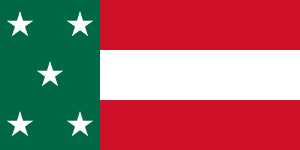
In 1836, a literary group called the Academía de Letrán was founded. Quintana Roo was named its president for life. He brought respect and importance to the group. This group wanted to create unique Mexican literature, free from Spanish influence.
In 1838, during the Pastry War with France, Quintana Roo offered money to help the war effort. He sent a letter to the president, Anastasio Bustamante. Bustamante refused the money but published the letter as an example of patriotism.
On March 30, 1841, Quintana Roo's father died. That same month, the state of Yucatán declared its independence from Mexico. Mexico had already lost Texas in 1836. They did not want to lose another state. In November, Quintana Roo was sent to Mérida to talk with Yucatán. He successfully convinced them to rejoin Mexico before the new year.
On August 21, 1842, his beloved wife, Leona Vicario, passed away. He was very sad but found comfort in his daughters, his writing, and his work. Nine years later, on April 15, 1851, Andrés Quintana Roo died from pneumonia in Mexico City. He is buried next to his wife, Leona, in the mausoleum at the Column of Independence in Mexico City.
Legacy and Remembrance
Andrés Quintana Roo's name is still honored in Mexico today. The state of Quintana Roo, located on the Yucatán peninsula, is named after him. The soccer stadium in Cancún also bears his name.
You can find statues and busts of Quintana Roo across the country. There are statues in Mérida, Chetumal, Solidaridad, and Mexico City. Busts are on Isla Mujeres and Cozumel.
A public library in Mexico City is named after him. Many roads and schools throughout Mexico also carry his name. He was even featured on Mexican money, on the MXP$20,000 and MXN$20 bills.
Images for kids
See also
 In Spanish: Andrés Quintana Roo para niños
In Spanish: Andrés Quintana Roo para niños
- Constitutions of Mexico


